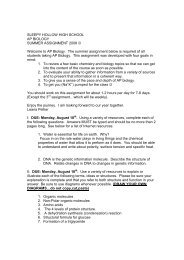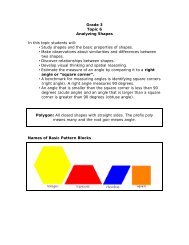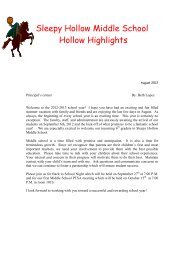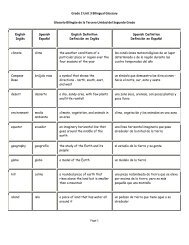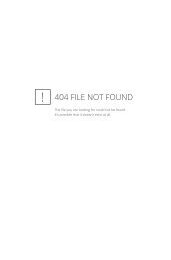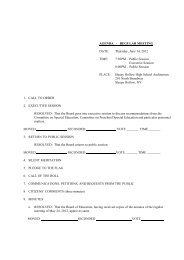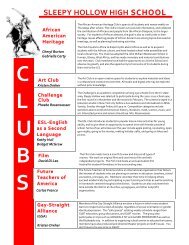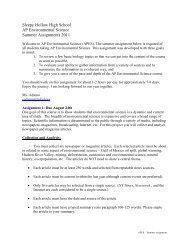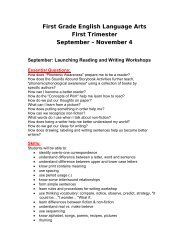Grade 3 Mathematics Third Trimester March 17 – June 15
Grade 3 Mathematics Third Trimester March 17 – June 15
Grade 3 Mathematics Third Trimester March 17 – June 15
Create successful ePaper yourself
Turn your PDF publications into a flip-book with our unique Google optimized e-Paper software.
<strong>Grade</strong> 3 <strong>Mathematics</strong><br />
<strong>Third</strong> <strong>Trimester</strong><br />
<strong>March</strong> <strong>17</strong> <strong>–</strong> <strong>June</strong> <strong>15</strong><br />
(Check out our Math Parent Resources at<br />
http://www.tufsd.org/wi/mathresources/grade3.html )<br />
End of <strong>March</strong>: Using Data and Making Predictions<br />
Essential Questions:<br />
Do I know that graphs are used to display information that describes<br />
a situation or a set of events?<br />
How can I use the information from a graph to make a prediction?<br />
Skills:<br />
Read and use information from a map to solve problems related to it.<br />
Develop increased fluency in addition of whole numbers.<br />
Make predictions and justify conclusions based on data.<br />
Represent data on a line plot.<br />
Collect, organize, and represent data using graphs.<br />
Propose and justify conclusions that are based on data.<br />
Analyze data.<br />
Read and interpret data in a table and graph.<br />
Exploring Fractional Relationships<br />
Essential Questions:<br />
Do I understand that fractions are equal parts of a whole?<br />
How do I compare fractions?<br />
How do fractions relate to division or whole numbers?
Skills:<br />
Use models and benchmarks to judge the size of fractions.<br />
Develop understanding of fractions as equal parts of a whole or equal<br />
parts of a collection or set.<br />
Demonstrate understanding of fractions as locations on a ruler or<br />
number line.<br />
Extend counting by halves to counting by fourths.<br />
Compare and order fractions using models of fractions.<br />
Recognize and create equivalent forms of a fractional amount.<br />
Use benchmarks to compare and order fractions.<br />
Demonstrate understanding of fractions as divisions of whole<br />
numbers.<br />
Describe separating a whole into equal groups with a division<br />
sentence and a fraction sentence.<br />
April: Working with Time<br />
Essential Questions:<br />
Can I calculate intervals of time using hours and minutes?<br />
Skills:<br />
Interpret information on a time line.<br />
Develop understanding of the meaning of a.m. and p.m.<br />
Tell time past the hour at 5 minute intervals, and 1 minute intervals.<br />
Understand the movements of the hands on a clock.<br />
Solve problems involving time.<br />
Explore strategies for calculating intervals of time.<br />
Estimate intervals of time.<br />
Capacity and Weight<br />
Essential Questions:<br />
Do I know what capacity and weight is?<br />
Skills:<br />
Understand the meaning of capacity.<br />
Explore relationships among cups, pints, quarts, and gallons.<br />
Understand the meaning of weight.<br />
Explore the relationship between kilograms and grams, pounds and<br />
ounces.<br />
Use logic to order objects according to weight.
May & <strong>June</strong>: Focusing on the Common Core<br />
Skills within each domain:<br />
Operations and Algebraic Thinking<br />
Represent and solve problems involving multiplication and division.<br />
• Interpret products of whole numbers e.g., interpret 5 x 7 as the total<br />
number of objects in 5 groups of 7 objects each. For Example,<br />
describe a context in which a total number of objects can be<br />
expressed as 5 x 7.<br />
• Interpret whole-number quotients of whole numbers, e.g., interpret<br />
56 / 8 as the number of objects in each share when 56 objects are<br />
partitioned equally into 8 shares, or as a number of shares when 56<br />
objects are partitioned into equal shares of 8 objects each. For<br />
example, describe a context in which a number of shares or a<br />
number of groups can be expressed as 56 / 8.<br />
• Use multiplication and division within 100 to solve word problems in<br />
situation involving equal groups, arrays, and measurement<br />
quantities, e.g., by using drawings and equations with a symbol for<br />
the unknown number to represent the problem.<br />
• Determine the unknown whole number in a multiplication or division<br />
equation relating three whole numbers. For example, determine the<br />
unknown number that makes the equation true in each of the<br />
equations 8 x ?= 48, 5 = ? / 3, 6 x 6 =?<br />
• If time permits!<br />
o Apply properties of operations as strategies to multiply and<br />
divide. Review distributive property, commutative property,<br />
and associative property.<br />
Number and Operations in Base Ten<br />
• Use place value understanding to round whole numbers to nearest<br />
10 or 100.<br />
• Review: Multiply 1 digit numbers by multiple of 10 in the range 10-90<br />
(eg 9 x 80)
Number and Operations <strong>–</strong> Fractions<br />
• Represent a fraction 1/b on a number line diagram by defining the<br />
interval from 0 to 1 as the whole and portioning it into b equal parts.<br />
Recognize that each part has size 1/b and that the endpoint of the<br />
part based at 0 locates the number 1/b on the number line.<br />
• Recognize and generate simple equivalent fractions (eg ½ = 2/4)<br />
Explain why the fractions are equivalent by using a visual fraction<br />
model.<br />
• (review) Express whole numbers as fractions and recognize fractions<br />
that are equivalent to whole numbers (eg 3 = 3/1)<br />
• Compare 2 fractions with the same numerator or the same<br />
denominator by reasoning by their size. Recognize that comparisons<br />
are valid only when the 2 fractions refer to the same whole. Record<br />
the results of comparisons with the symbols greater than/less than<br />
and justify the conclusion (eg using a fraction model)<br />
Measurement and Data<br />
• Tell and write time to the nearest minute and measure time intervals<br />
in minutes. Solve word problems involving addition and subtraction<br />
in time intervals in minutes (eg representing the problem on a<br />
number line diagram)<br />
• Draw a scaled pictograph and a scaled bar graph to represent a data<br />
set with several categories. Solve one and two step “how many<br />
more” and “how many less” problems using information presented<br />
in scaled bar graph.<br />
• Measure area by counting unit squares AND relate area to<br />
multiplication and addition. (Suggestion: clarify difference between<br />
area and perimeter)<br />
Geometry<br />
• Partition shapes into parts with equal area. Express the area of each<br />
part as a unit fraction of the whole.



